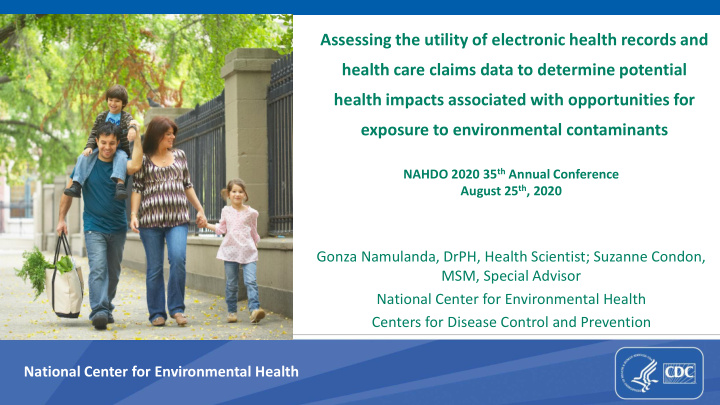



Assessing the utility of electronic health records and health care claims data to determine potential health impacts associated with opportunities for exposure to environmental contaminants NAHDO 2020 35 th Annual Conference August 25 th , 2020 Gonza Namulanda, DrPH, Health Scientist; Suzanne Condon, MSM, Special Advisor National Center for Environmental Health Centers for Disease Control and Prevention National Center for Environmental Health
Disclaimer ▪ The findings and conclusions in this presentation are those of the author(s) and do not necessarily represent the official view of the Centers for Disease Control and Prevention.
Outline ▪ Introduction ▪ Background ▪ Methods ▪ Preliminary results ▪ Lessons learned ▪ Next steps
Introduction ▪ Health care claims (HCC) and electronic health records (EHRs) might enhance early warning surveillance • Timely • Geographically refined • More information, e.g., risk factors, co-diagnosis, pharmacy and laboratory test results
Background ▪ The city of New Castle, DE selected for a pilot study • A variety of industrial sources are present • In 2015, levels of contaminants in drinking water were found to be above federal health advisory levels • Universal claims and access to EHR data available through the Delaware Health Information Network (DHIN)
Methods ▪ Population: health care plan members who resided in New Castle County during the period 2013 – 2018 ▪ Area/zip codes of interest: 19720, 19702 and 19713
Methods cont. ▪ Health outcomes of interest: cardiovascular disease; hypertension; diabetes, high cholesterol, thyroid disease; kidney cancer; and testicular cancer ▪ Calculated percent of: • Health care plan members with health outcomes of interest by year
Preliminary results Table 1. Number and percent of all health care plan members with health outcome of interest
Preliminary results cont. Table 2. Number and percent of health care plan members with health outcome of interest stratified by age and gender
Next steps ▪ Evaluate comparability of DHIN data in relation to population-based surveillance data for DE ▪ Examine differences in rates of health outcomes before and after remediation ▪ Obtain clinical data of the same health outcomes in the area of interest
Lessons learned ▪ Data request, approval, and acquisition process should be factored into project timelines ▪ Need for collaboration between HIEs and Public Health • Data quality questions • Detect and understand patterns in data
Acknowledgments ▪ Delaware Health ▪ MedicaSoft Information Network • Vlad Racovita • TerriLynn Palmer • Carmen Olariu • Pier Straws • Gurpeet Kaur ▪ Freedman healthcare • Elizabeth Ellis • Tanya Bernstein
Thank You! For more information, contact NCEH 1-800-CDC-INFO (232-4636) TTY: 1-888-232-6348 www.cdc.gov The findings and conclusions in this report are those of the authors and do not necessarily represent the official position of the Centers for Disease Control and Prevention.
Recommend
More recommend